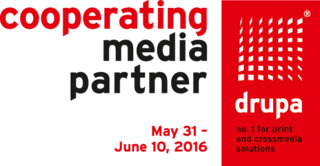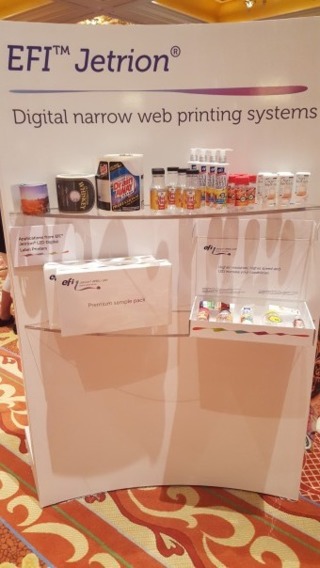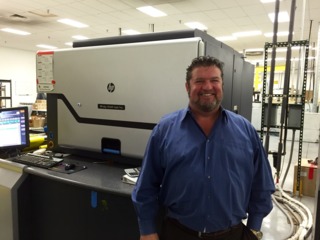Packaging and Labels at drupa 2016
In Dusseldorf come late May, the beer will be flowing along with innovative ideas for the future of printing labels and packages.

Full-bodied glasses of Frankenheim Alt beer, the local favorite brew, will be flowing freely come late May and early June evenings in the altstadt (old town) of Düsseldorf, Germany, when the now triennial drupa printing trade fair runs this coming spring. Prior to nightly dinners and pub runs, literally hundreds of thousands of attendees will be busy walking the massive show floor, which features nearly 2,000 exhibitors and is open for 11 days (May 31-June 10).
The 2016 edition of the big exposition is set to feature a Packaging Touchpoint show within the show focused on production. Paper with unique sensory appeal combined with excellent finishing techniques turns packaging into first class advertising media, the show organizers contend. Electronic displays and sensors make packaging intelligent, while digital printing allows personalization and versioning. “Our aim is to use the visionary Touchpoint to identify potential in packaging design and production and address important vertical markets,” said Sabine Geldermann, drupa director. The touchpoint is geared towards brands, packaging designers, and service providers already operating in the packaging sector or planning to enter this sector.
This special forum in Hall 12 is designed and implemented in close collaboration with the European Packaging Design Association (epda), Europe's leading association of brands and packaging agencies. “We will cover the entire spectrum of the packaging world: from technical/functional requirements, cultural and ethical considerations, cost-effectiveness and efficiency to the wide range of substrates and the technologies used,” explained Claudia Josephs, project manager at epda. To fulfill the special needs of the various user industries better, Packaging Touchpoint will be divided into four “future labs:” food and beverage, non-food, pharma, and cosmetics. Successful practical examples as well as potential future production solutions should inspire visitors.
HP is poised to be drupa’s largest exhibitor, over taking the big spot once held by Heidelberg. A revamping of the floor plan will see HP take over an entire hall. Competitors will be there, too, of course, including EFI, which is focused more now on packaging than ever before. At the EFI Connect user conference in January, CEO Guy Gecht said that over the next three to five years, the firm will place a heavy focus on textile and package printing. One major announcement at Connect was the release of the new Corrugated Packaging Suite, which provides a variety of features including corrugated scheduling and trimming, plant converting scheduling and planning, data collection, and roll stock inventory management.
“Packaging is a growing market,” Gaby Matsliach, EFI’s senior VP and GM of productivity software, said. “In packaging, digital becomes a growing factor. Our responsibility is better support for our packaging offerings.” In addition to the new corrugated suite, Matsliach said EFI’s packaging productivity suite has undergone a major investment to help it become more complete, now featuring integration with Esko automation and advanced layout optimization for labels and folding cartons.
In terms of inkjet printing, Ken Hanulec, EFI VP of marketing for inkjet solutions, said that the firm’s inkjet solutions in packaging will experience growth in the near future. He explained that LED is a big part of its inkjet portfolio, which includes Jetrion label presses. Hanulec also stated that Jetrion has approached nearly 300 installations.
The short term focus for EFI’s line of Jetrion presses includes polypropylene friendly or PP lasers for thin films, Radius integration, and Esko Plug-in VDP. Hanulec also mentioned that he sees opportunity for high-speed digital inkjet in the corrugated market.
Expect to see Fujifilm’s Graphium at drupa also. Graphium is a versatile UV digital inkjet press specifically designed for labels, packaging, and specialty print. Its unique design provides versatility and functionality while incorporating inkjet, flexographic printing, and finishing, all in one.
The X Factor
Xerox Corp. is among the most buzz leading up to the big European show. In late November 2015, billionaire activist investor Carl Icahn disclosed a new 7.1 percent stake in Xerox, making him the second largest shareholder in what he called an “under-valued” firm. Then in late January of this year, CEO Ursula Burns announced that the company will be split into two publicly traded companies. Despite its stock struggles on Wall Street, “the X factor” is planning a strong showing across the Atlantic. One watchful competitor told me that Xerox is poised “to be a major player in the industrial and packaging space, where it really doesn’t play today.”
Is it true? Well, yes, “over time,” said John DiVincenzo, head of the digital packaging business team at Xerox, whose digital presses have been producing folding cartons for converters for seven years now. “Our iGen-based folding carton solution allows for small runs of packages.” Upgrades to this main offering include additional colors (up to five) and extra-thick stock capabilities while still handling thin paper, too. “This flexibility is ideal for commercial printers,” he pointed out. But it is clear that these iGen advancements are merely the tip of the iceberg. “Going forward, we will be working even more closely with partners for coatings, diecutting and other services and effects.”
Beyond digital folding carton production, DiVincenzo said it is still a bit early to reveal what else Xerox will show at drupa. Suffice it to say that “we will leverage Xerox’s IP [intellectual property] and capabilities.”
He identified an overarching packaging theme: “There is a fundamental belief set that brand owners have an expectation of the value-add that digital [package printing] can bring, and they rely on converters,” DiVincenzo noted, pointing to three basic digital-print tenets:
- The value of variable content.
- Faster time to market.
- Getting to more customers in a more targeted way.
Digital and Flexo
These points hit home for David Strummer, who heads up business development for trade service provider Abbott Labels, which is based in Dallas and has a pair of manufacturing facilities there as well as one each in Atlanta, Chicago, and Los Angeles. Shopper connection is a trend bearing financial fruit for Abbott and its customers. “Including a charity emblem on a label, such as the breast-cancer awareness pink ribbon or American Heart Association’s red heart, is a great way for smaller businesses to relate and connect with consumers,” he said.
The HP Indigo WS6600 Digital Press that Abbott Labels installed in mid-2013 allows small “mom-and-pops” to compete using short press runs and variable content. “This technology lowers the liability for start-up companies with only 70 to 80 SKUs, Strummer added.
On the flexo analog side, president John Abbott sees a push toward printing equipment getting smaller – “smaller cones and smaller outside diameters,” he said. The company has been running Mark Andy narrow-web presses for three decades and made the switch to Kodak Flexcel NX plates. Thinner liners, too, allow more labels to a roll. “The industry standard was 40-lb., 2.8-mil. liner,” Abbott noted, “but now we’ve gone to 1.7-mil.” How much difference does that 1/1,000th of an inch make to productivity? “We can get 1,500 instead of 1,000 labels from a three-inch core with an eight-inch outside diameter,” Abbott reported, equating to 33.3 percent more labels. And while a thinner liner does not affect the tension on a narrow-web, flexographic press, it does require the significant upfront cost of a new die; so the volume needs to be there to justify that investment.


